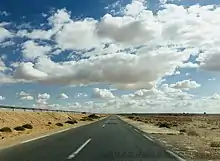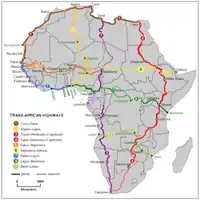Trans-Sahara Highway
The Trans-Sahara Highway or TAH 2, also known as the African Unity Road, is a transnational highway project nearing completion to pave, improve and ease border formalities on an existing trade route running north–south across the Sahara Desert. It runs between North Africa bordered by the Mediterranean Sea in the north and West Africa bordered by the Atlantic Ocean in the south, from Algiers in Algeria to Lagos in Nigeria, giving it the alternative names of the Algiers–Lagos Highway or Lagos–Algiers Highway.
 | ||||
|---|---|---|---|---|
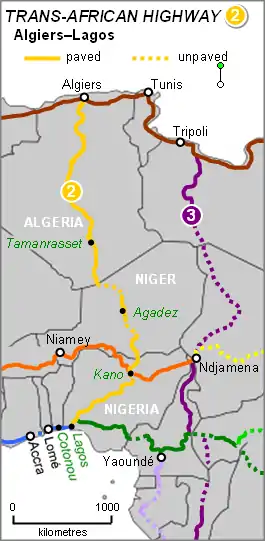 | ||||
| Route information | ||||
| Length | 4,504 km (2,799 mi) | |||
| Major junctions | ||||
| North end | ||||
| South end | ||||
| Location | ||||
| Highway system | ||||
| ||||
| ||||
The Trans-Sahara Highway is one of the oldest transnational highways in Africa and one of the most complete, having been proposed in 1962, with construction of sections in the Sahara starting in the 1970s. Its central section has become little-used, and is currently closed to tourists and requires military convoys due to restrictions in Algeria and migrant trafficking with associated insecurity in northern Niger.
Route and status
Overall features, length and condition
The Trans-Sahara Highway[1] has a length of about 4,500 km of which about 98% has been paved. It passes through three countries: Algeria, Niger and Nigeria. However, an additional 3,600 km of linked highways to Tunisia, Mali, Chad and Mauritania are considered by planners to be integral to the Trans-Sahara Highway network.
The 1,200 km of the highway in Nigeria are part of that country's national paved road network and include nearly 500 km of four-lane divided sections, but highway maintenance is frequently deficient and parts of the road may be in poor condition.
About half the highway, over 2,300 km, lies in Algeria and is mostly in good condition, with the newest sections south of Tamanrasset. From the Algerian border town of In Guezzam to 'Point Zero' on the Niger border is now sealed, with a sand berm extending to either side to disrupt migrant trafficking.[2][3]
Niger has 985 km of the highway and in 2023 some 900 km had been asphalted, although parts are in poor condition in the south. Further details are given below.
Another crossing of the Sahara was proposed for the Tripoli–Cape Town Highway (Trans-African Highway 3) but this route requires a great deal more construction, faces problems of instability and lawlessness in southern Libya and northern Chad, and is not likely to stimulate trade to the same extent as TAH 2. It may be decades away from completion.
Two other Trans-African Highways cross the Sahara, but at its edges. In 2005 the Cairo–Dakar Highway (TAH 1) in the west along the Atlantic coast became the first fully sealed highway crossing the Sahara from north to south (barring a few kilometres in No Man's Land between Morocco/Western Sahara and Mauritania).[4] The Cairo–Cape Town Highway (TAH 4) follows the Nile in the east, the previous long unpaved sections in Sudan, Ethiopia and Kenya have since been significantly improved. The highway from Nanyuki in Kenya to Moyale at the Ethiopian border is an excellent tarmac road. The roads in Ethiopia and Sudan are all tarmac of good quality as at October 2020.
Announced in 2018,[5] by 2019 a third trade route opened up between Algeria and Mauritania, but has yet to be classified. Established during the French colonial era as a link between Algiers with Dakar to avoid the then Spanish Sahara on the Atlantic, it was closed in 1963. Currently tarmac ends on the Algerian border just south of Tindouf and resumes some 900-kilometres later at Zouerat, passing via Bir Moghrein.[6]
Route
a.jpg.webp)
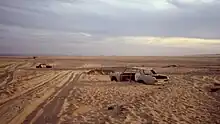
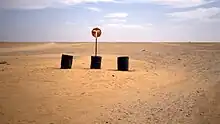
The cities and countries served, and status of the road are as follows.
In Algeria
- Algiers to Ghardaia, 625 km, paved, in good condition
- Ghardaia to Tamanrasset, 1,291 km, paved in good condition
- Tamanrasset to In Guezzam at the Niger border, 400 km, paved.
- In Guezzam to Assamaka, the Niger border post: 28 km sealed to 'Point Zero', thereafter soft sand tracks possible in high clearance vehicles.
See also: Algeria–Niger border
In Niger
- Assamaka to Arlit, 210 km. In 2023 less than 100km of marked track remain, followed by new tarmac southeast to Arlit.[7]
- Arlit to Agadez, 243 km, paved in 1980 and probably recently repaved.
- Agadez to Zinder, 431 km, paved.[8]
- Zinder-Magaria at the Nigerian border, 111 km, paved but in poor condition.
See also: Niger-Nigeria border
In Nigeria
- Niger border to Lagos via Kano, Kaduna, Oyo, Ibadan: 1,193 km of which 127 km is in good condition and 1,066 km 'fair'.
In summary, although ageing paved sections will always deteriorate and require maintenance, currently less than 100 km of the route east of Assamaka remains a marked sandy track. The Trans-Sahara Highway via the central Sahara may well soon be sealed.
Links to other transnational highways
The Trans-Sahara Highway intersects with:
- Cairo–Dakar Trans-African Highway in Algiers
- Trans-Sahelian Highway in Kano, Nigeria
- Trans–West African Coastal Highway in Lagos
- Lagos–Mombasa Highway in Lagos
See also
References
- "Trans Sahara Routes". 15 May 2023.
- "In-Guezzam: lancement du dernier tronçon de la transsaharienne aux frontières avec le Niger". 20 February 2022.
- https://sahara-overland.com/routes/
- https://sahara-overland.com/2020/04/03/a-if-for-atlantic-highway/
- "Ouverture de la route Choum -Tindouf : Une revendication pressante des Mauritaniens du Nord Est".
- "Mauritania". 15 May 2023.
- https://sahara-overland.com/routes/
- Michelin Map 741, 2014
Sources
- "Sahara Overland; Trans Sahara Routes".. Retrieved 15 May 2023.
- African Development Bank/United Nations Economic Commission For Africa: "Review of the Implementation Status of the Trans African Highways and the Missing Links: Volume 2: Description of Corridors". August 14, 2003. Retrieved 14 July 2007.
